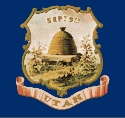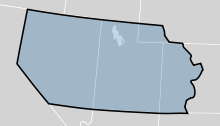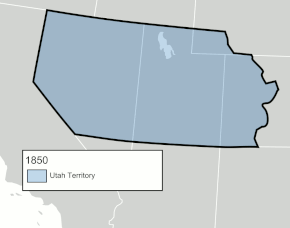| Revision as of 10:24, 18 September 2024 edit2601:14d:4b80:1950:947:4f6b:517:7658 (talk)No edit summaryTags: Reverted references removed Visual edit Mobile edit Mobile web edit← Previous edit | Revision as of 10:43, 18 September 2024 edit undo2601:14d:4b80:1950:947:4f6b:517:7658 (talk)No edit summaryTags: Reverted Visual edit Mobile edit Mobile web editNext edit → | ||
| Line 57: | Line 57: | ||
| When the ] moving west across the ] from ] and other Mid-Western states and began settling the | When the ] moving west across the ] from ] and other Mid-Western states and began settling the | ||
| The Utah Territory was organized by an ] of the ] in ], on the same day that the ] was admitted to the Union |
The Utah Territory was organized by an ] of the ] in ], on the same day that the ] on the ] and west coast of the continent was admitted to the Union as the 31st state along with to the south of the ] was authorized and organized (including originally the later territory by 1863, then state of ] in ], in its western half) added for the southern portion of the former ] lands, following their defeat in the ] of 1846-1849, and subsequent treaty of peace. The creation of the territories was part of the ] that sought to preserve the balance of power between Southern slave and Northern free states.<!-- must check this: California was admitted as free state, and the Utah Territory was organized as a slave territory. --> With the exception of a small area around the headwaters of the ] in present-day ], the United States had acquired all the land of the territory from ] with the ] of 1848, restoring peace. After passing the upper chamber of Congress of the ], then the lower chamber of the House of Representatives voted in favor of organizing the new larger Territory of Utah,97–85.<ref>"". ''The National Era'' (Washington, D.C.). Newspapers.com. September 12, 1850. p. 3.</ref> | ||
| The creation of the Territory<!--, albeit not as a slave territory,--> was partially the result of a petition sent by the pioneers under the leadership of ]. The petition had asked Congress to allow them to enter the Union as the ], with its capital as ] and with proposed borders that encompassed the entire ] and the watershed of the ], including all or part of nine current U.S. states. The Mormon settlers had drafted a state constitution in 1849 and Deseret had become the ''de facto'' government in the Great Basin by the time of the creation of the Utah Territory.<ref name=Alford>{{cite book|author=Alford, Kenneth L. |title=Utah and the American Civil War: The Written Record|url=https://books.google.com/books?id=1_stDwAAQBAJ&pg=PA801 |year=2017 |publisher=University of Oklahoma Press|isbn=978-0-8061-5916-4 |page=801}}</ref> | The authorization and creation of the Territory<!--, albeit not as a slave territory,--> was partially the result of a petition sent by the pioneers under the leadership of ]. The petition had asked Congress to allow them to enter the Union as the ], with its capital as ] and with proposed borders that encompassed the entire ] and the watershed of the upper ], including all or part of nine current U.S. states. The Mormon settlers had drafted a state constitution in 1849 and that Deseret had become the ''de facto'' government in the Great Basin and Rocky Mountains by the time of the later official creation of the Utah Territory.<ref name=Alford>{{cite book|author=Alford, Kenneth L. |title=Utah and the American Civil War: The Written Record|url=https://books.google.com/books?id=1_stDwAAQBAJ&pg=PA801 |year=2017 |publisher=University of Oklahoma Press|isbn=978-0-8061-5916-4 |page=801}}</ref> | ||
| Following the organization of the territory, Young was inaugurated as its first governor on February 3, 1851. In the first session of the territorial legislature in September, the legislature adopted all the laws and ordinances previously enacted by the General Assembly of the State of Deseret. | Following the organization of the territory, Young was inaugurated as its first governor of the Territory on February 3, 1851. In the first session of the territorial legislature in that September, the legislature adopted all the laws and ordinances previously enacted by the former General Assembly of the State of Deseret. | ||
| During Brigham Young's governorship, he exerted considerable power over the territory. An example being that in ], the territory legislature gave Young the exclusive right to manufacture whiskey.<ref>{{cite book |last1=Vance |first1=Del |title=Beer in the Beehive |date=2008 |publisher=Dream Garden Press |location=Salt Lake City |page=32 |edition=2}}</ref> | During Brigham Young's governorship, he exerted considerable power over the territory. An example being that in ], the territory legislature gave Young the exclusive right to manufacture and distil whiskey.<ref>{{cite book |last1=Vance |first1=Del |title=Beer in the Beehive |date=2008 |publisher=Dream Garden Press |location=Salt Lake City |page=32 |edition=2}}</ref> | ||
| Mormon governance in the territory was regarded as controversial by much of the rest of the nation, partly fed by continuing lurid newspaper depictions of the ] practiced by the settlers, which itself had been part of the cause of their flight from the United States to the ] basin after being forcibly removed from their settlements farther east. | Mormon governance in the territory was regarded as controversial by much of the rest of the nation, partly fed by continuing lurid newspaper depictions of the ] practiced by the settlers, which itself had been part of the cause of their flight from the United States to the ] basin after being forcibly removed from their settlements farther east. | ||
Revision as of 10:43, 18 September 2024
Territory of the U.S. between 1850-1896
| Territory of Utah | |||||||||
|---|---|---|---|---|---|---|---|---|---|
| Organized incorporated territory of the United States | |||||||||
| 1850–1896 | |||||||||
 Flag
Flag
 Territorial coat of arms (1876)
Territorial coat of arms (1876)
| |||||||||
 The Utah Territory upon its creation, with modern state boundaries shown for reference | |||||||||
| Capital |
| ||||||||
| Government | |||||||||
| • Type | Organized incorporated territory | ||||||||
| Governor | |||||||||
| • 1851–58 | Brigham Young | ||||||||
| • 1858–61 | Alfred Cumming | ||||||||
| • 1875–80 | George W. Emery | ||||||||
| • 1880–86 | Eli Houston Murray | ||||||||
| • 1886–89, 1893–96 | Caleb Walton West | ||||||||
| Legislature | Utah Territorial Assembly | ||||||||
| History | |||||||||
| • State of Deseret | 1849 | ||||||||
| • Utah Organic Act | 9 September 1850 | ||||||||
| • Colorado Territory formed | February 28, 1861 | ||||||||
| • Nevada Territory formed | March 2, 1861 | ||||||||
| • Wyoming Territory formed | July 25, 1868 | ||||||||
| • Statehood | 4 January 1896 | ||||||||
| |||||||||
The Territory of Utah was an organized incorporated territory of the United States that existed from September 9, 1850, until January 4, 1896, when the final extent of the territory was admitted to the Union as the State of Utah, the 45th state. At its creation, the Territory of Utah included all of the present-day State of Utah, most of the present-day state of Nevada save for Southern Nevada (including Las Vegas), much of present-day western Colorado, and the extreme southwest corner of present-day Wyoming.
History
When the Mormon pioneers moving west across the Mississippi River from Illinois and other Mid-Western states and began settling the
The Utah Territory was organized by an Organic Act of the United States Congress in 1850, on the same day that the State of California on the Pacific Ocean and west coast of the continent was admitted to the Union as the 31st state along with to the south of the New Mexico Territory was authorized and organized (including originally the later territory by 1863, then state of Arizona in 1912, in its western half) added for the southern portion of the former Mexican Cession lands, following their defeat in the Mexican–American War of 1846-1849, and subsequent treaty of peace. The creation of the territories was part of the Compromise of 1850 that sought to preserve the balance of power between Southern slave and Northern free states. With the exception of a small area around the headwaters of the Colorado River in present-day Colorado, the United States had acquired all the land of the territory from Mexico with the Treaty of Guadalupe Hidalgo of 1848, restoring peace. After passing the upper chamber of Congress of the United States Senate, then the lower chamber of the House of Representatives voted in favor of organizing the new larger Territory of Utah,97–85.
The authorization and creation of the Territory was partially the result of a petition sent by the pioneers under the leadership of Brigham Young. The petition had asked Congress to allow them to enter the Union as the State of Deseret, with its capital as Salt Lake City and with proposed borders that encompassed the entire Great Basin and the watershed of the upper Colorado River, including all or part of nine current U.S. states. The Mormon settlers had drafted a state constitution in 1849 and that Deseret had become the de facto government in the Great Basin and Rocky Mountains by the time of the later official creation of the Utah Territory.
Following the organization of the territory, Young was inaugurated as its first governor of the Territory on February 3, 1851. In the first session of the territorial legislature in that September, the legislature adopted all the laws and ordinances previously enacted by the former General Assembly of the State of Deseret.
During Brigham Young's governorship, he exerted considerable power over the territory. An example being that in 1873, the territory legislature gave Young the exclusive right to manufacture and distil whiskey.
Mormon governance in the territory was regarded as controversial by much of the rest of the nation, partly fed by continuing lurid newspaper depictions of the polygamy practiced by the settlers, which itself had been part of the cause of their flight from the United States to the Great Salt Lake basin after being forcibly removed from their settlements farther east.
Although the Mormons were the majority in the Great Salt Lake basin, the western area of the territory began to attract many non-Mormon settlers, especially after the discovery of silver at the Comstock Lode around ithe Virginia City, Nevada area near its western border with California and Lake Tahoe in 1858. Only three years later in 1861, partly as a result of this tremendous silver strike, that the new Nevada Territory was created out of the western part of the formerly larger Utah Territory. Non-Mormons also entered the easternmost part of the territory during the Pikes Peak Gold Rush, resulting in the discovery of gold at Breckenridge in Utah Territory in 1859. In that same pivotal year of 1861, a large portion of the opposite eastern area of the Utah territory was reorganized and attached as part of the newly created Colorado Territory to the east.
In 1869, the Territory of Utah's legislature approved and ratified women's suffrage.
46 years elapsed between the organization of the Territory and its admission to the Union in 1896 as the 45th State of Utah, long after the admission of territories created later after it. In contrast, the Nevada Territory, although more sparsely populated, was admitted to the Union in 1864, only three years after its territorial formation, and Colorado was admitted ias the 38th state in 1876 after almost 15 years as a territory..

Coat of arms
The Utah state coat of arms appears on the state seal and state flag. The beehive was chosen as the emblem for the provisional State of Deseret in 1848 and represents the state's industrious and hard-working inhabitants, and the virtues of thrift and perseverance. The sego lilies on either side symbolize peace.
Population
| Year | Pop. | ±% |
|---|---|---|
| 1850 | 11,380 | — |
| 1860 | 40,273 | +253.9% |
| 1870 | 86,336 | +114.4% |
| 1880 | 146,608 | +69.8% |
| 1890 | 210,779 | +43.8% |
| Source: 1850–1890 | ||
In 1850, nine churches with regular services in the Utah Territory were unclassified by historian Edwin Gaustad in his Historical Atlas of Religion in America (1962), but were probably LDS churches. In the 1890 United States census, 25 counties in the Utah Territory reported the following population counts (after seven reported the following counts in the 1850 United States census):
| 1890 Rank |
County | 1850 Population |
1890 Population |
|---|---|---|---|
| 1 | Salt Lake | 6,157 | 58,457 |
| 2 | Utah | 2,026 | 23,768 |
| 3 | Weber | 1,186 | 22,723 |
| 4 | Cache | – | 15,509 |
| 5 | Sanpete | 365 | 13,146 |
| 6 | Summit | – | 7,733 |
| 7 | Box Elder | – | 7,642 |
| 8 | Davis | 1,134 | 6,751 |
| 9 | Sevier | – | 6,199 |
| 10 | Juab | – | 5,582 |
| 11 | Emery | – | 5,076 |
| 12 | Millard | – | 4,033 |
| 13 | Washington | – | 4,009 |
| 14 | Tooele | 152 | 3,700 |
| 15 | Wasatch | – | 3,595 |
| 16 | Beaver | – | 3,340 |
| 17 | Piute | – | 2,842 |
| 18 | Uintah | – | 2,762 |
| 19 | Iron | 360 | 2,683 |
| 20 | Garfield | – | 2,457 |
| 21 | Morgan | – | 1,780 |
| 22 | Kane | – | 1,685 |
| 23 | Rich | – | 1,527 |
| 24 | Grand | – | 541 |
| 25 | San Juan | – | 365 |
| Indian reservations | 4,645 | – | |
| Utah Territory | 11,380 | 210,779 |
See also
References
- "FlagTerritorial.jpg". pioneer.utah.gov. Archived from the original on June 23, 2012. Retrieved May 6, 2021.
- 9 Stat. 453
- "Utah". World Statesmen. Retrieved July 20, 2015.
- "Friday, September 6, 1850". The National Era (Washington, D.C.). Newspapers.com. September 12, 1850. p. 3.
- ^ Alford, Kenneth L. (2017). Utah and the American Civil War: The Written Record. University of Oklahoma Press. p. 801. ISBN 978-0-8061-5916-4.
- Vance, Del (2008). Beer in the Beehive (2 ed.). Salt Lake City: Dream Garden Press. p. 32.
- Lemay, Kate Clarke; Goodier, Susan; Tetrault, Lisa; Jones, Martha (2019). Votes for Women: A Portrait of Persistence. Princeton University Press. p. 270. ISBN 9780691191171.
- Utah State Coat of Arms State Symbols USA.
- Utah State Emblem: Beehive eReferenceDesk.
- ^ Forstall, Richard L. (ed.). Population of the States and Counties of the United States: 1790–1990 (PDF) (Report). United States Census Bureau. pp. 162–163. Retrieved May 18, 2020.
- Selcer, Richard F. (2006). Balkin, Richard (ed.). Civil War America: 1850 to 1875. New York: Facts on File. p. 143. ISBN 978-0816038671.
- Gaustad, Edwin (1962). Historical Atlas of Religion in America. New York: Harper & Row.
Further reading
- (1994) "Coins and Currency" article in the Utah History Encyclopedia. The article was written by Leonard J. Arrington and the Encyclopedia was published by the University of Utah Press. ISBN 9780874804256. Archived from the original on March 21, 2024 and retrieved on April 12, 2024.
- (2017) Unpopular Sovereignty: Mormons and the Federal Management of Early Utah Territory by Brent M. Rogers, University of Nebraska Press.
External links
- Utah in 1851, with the text of the 1850 Act of Congress to Establish the Territory of Utah, Central Pacific Railroad Photographic History Museum
- Utah's Role in the Transcontinental Railroad, Central Pacific Railroad Photographic History Museum
- Utah State History Archived April 20, 2021, at the Wayback Machine Utah Office of Tourism Official Website
- Henry Sommer, Watercolors and Pencil Drawings Related to the Utah Expedition. Yale Collection of Western Americana, Beinecke Rare Book and Manuscript Library.
| Territories of the United States | |
|---|---|
| |
| |
| |
| |
| |
| |
39°50′N 113°30′W / 39.833°N 113.500°W / 39.833; -113.500
Categories:- States and territories established in 1850
- States and territories disestablished in 1896
- Utah Territory
- Former organized territories of the United States
- History of the American West
- History of the Great Basin
- 19th century in Utah
- Pre-statehood history of Colorado
- Pre-statehood history of Nevada
- Pre-statehood history of Utah
- Pre-statehood history of Wyoming
- Utah War
- 1850 establishments in Utah Territory
- 1896 disestablishments in Utah